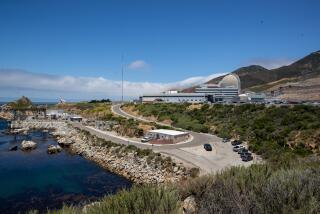It’s Not Just a Question of Welfare for Scientists : National panel joins debate on Lawrence Livermore lab
- Share via
The painful but necessary process of shrinking the nation’s nuclear weapons laboratories and redefining their missions has made a fitful beginning. A blue-ribbon panel appointed by the secretary of energy proposes to transfer weapons design work from Lawrence Livermore National Laboratory near San Francisco to Los Alamos National Laboratory in New Mexico over the next five years, along with responsibility for stewardship of the nuclear stockpile. Both labs are managed by the University of California.
The panel has thus opened a complex debate--as much political as scientific--that joins conflicting forces of national security, fiscal austerity and the future of the California economy. Though not unexpected, the proposal is a blow to Livermore, its 7,300 employees and the Bay Area, which benefits mightily from Livermore’s $1-billion annual budget but long has been ambivalent about being the host of the doomsday crowd. But the report did not, as some at the lab had feared, urge shuttering Livermore.
It is best for all concerned to recognize that the nation now enjoys a surplus of nuclear talent. Nuclear testing has been suspended, and 79% of the American nuclear arsenal will be dismantled over the next eight years. The panel, headed by Chairman Robert Galvin of Motorola, observed what is by now obvious: The 10 major Energy Department labs, which did heroic service both to national security and basic science, have grown bloated and are often poorly managed. Clearly the government will no longer spend more than $6 billion a year on these labs, given the redundancies and wasteful rivalries.
That said, this page has argued before that Livermore in particular represents a substantial national asset that should be preserved, in smaller form if necessary. The Galvin panel agreed, saying that Livermore should retain enough nuclear expertise to continue its important work in countering the proliferation of nuclear weapons and in verification of arms reduction treaties.
Livermore has staked its future largely on hopes for a $1-billion super laser called the National Ignition Facility, or NIF, useful for both weapons design and civilian energy research. The Galvin panel gave only lukewarm support to building NIF. Anti-nuclear weapons activists in the Bay Area complain that construction of the laser facility would strengthen Livermore’s hand in weapons work.
The Clinton Administration has argued that the labs potentially are an ideal bridge between high-risk costly basic research and industrial innovation to boost American competitiveness. But the Galvin panel sneered at that notion, saying that it is based on an outdated concept of how new products are developed and that lab efforts to cooperate with industry are “unfocused.” It said the labs should stick to certain areas of basic research. One possible role is in the cleanup of the 3,700 sites contaminated by plutonium and other toxic wastes at Energy Department installations around the country.
The bottom line is that the labs’ future remains very uncertain, the Galvin report being just one voice in a debate that has changed with the Republican ascendancy in Congress. The Republicans are at once committed to bolstering national defense and curbing government spending. It is to be hoped that ideology and parochial concerns about protecting turf and jobs take a back seat to the larger issue of preserving a resource that has been vital to the national security. That is not something easily reassembled once disbanded.
More to Read
Sign up for Essential California
The most important California stories and recommendations in your inbox every morning.
You may occasionally receive promotional content from the Los Angeles Times.













